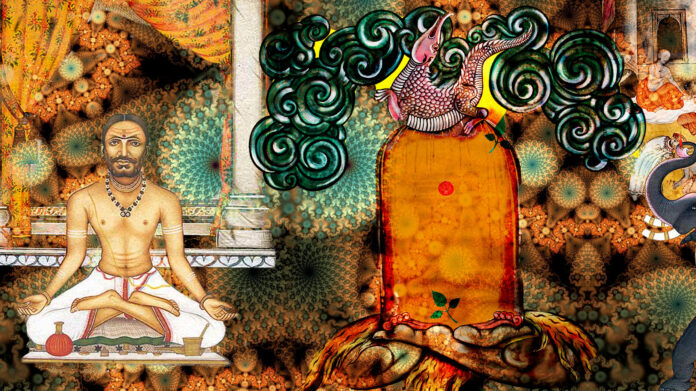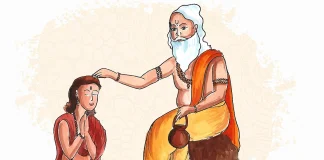Upanishadic sages thousands of years ago understood the secrets of neuroscience, but going beyond the physical body to higher levels of consciousness, ultimately transcending the manifest universe.
Vedic Deities (Devatas) can be defined relative to mind, sensory, pranic, and motor functions that can easily be correlated to the workings of the brain and the nervous system. For example, Agni or fire is speech, Vayu or air is Prana, Surya or the Sun is perception, space or the directions is hearing, and the Moon (Soma) is the mind in its contemplative nature. These are also the priests and powers of the Vedic sacrifice or Yajna, of which the inner sacrifice is the practice of Yoga.
By Dr. David Frawley
Through working with these Vedic Devatas we can develop methods and practices to activate the different aspects of the brain, the outer senses and pranas, and the inner senses and pranas, for individual well being. By connecting the Gods or Devas within, with those on the outside, we can promote their manifestation in the outer world.
Aitareya Upanishad – Upanishadic View of Evolution
The Aitareya Upanishad, which is the main Upanishad of the Rigveda, has profound teachings that can be interpreted relative to the brain, neuroscience and natural evolution.
The Aitareya Upanishad (AU I.1) describes the universe as a manifestation of the Self (Atman) through its power of vision. This means that everything manifested is a form of the Self or self-awareness.
It then describes the creation of the worlds (lokas) as five, the heavenly waters, heaven, atmosphere, earth, and the waters beneath the earth. The waters symbolize the vibratory waves of consciousness-space in which all the worlds are held.
It then describes the guardians of the worlds starting with the Purusha, indicating that the entire universe has the form of the human being or human body and exists in the brain. The other world guardians (loka palas) consist of Agni, from the mouth and speech of the Purusha; Vayu from the nose and the prana of the Purusha; the Sun from the eyes and vision of the Purusha; the directions of space from the ears and hearing of the Purusha; plants and trees from the skin and hairs of the Purusha; the Moon from the mind and the heart of the Purusha,; death from the navel and apana vayu of the Purusha; and the waters from the sex organ and the seed of the Purusha.
The Devatas so created were cast into the great ocean of the universe (AU I. 2), where they were stricken with hunger and thirst. They asked the Purusha to create an abode or embodiment for them where they could eat food and become satisfied (fully manifested).
Here is where we have an interesting correlate to the modern theory of evolution. First the Self brought the Devas a cow (gam), but they found it insufficient for them to fully enter. Second, he brought them a horse (ashva), but they also found it to be insufficient. Last he brought them a human being (Purusha) and they found it to be sufficient or well-made (sukrita). This implies that the human being has been brought into evolution by the universal Purusha for its own manifestation.
Then each of the Devatas entered into the human being as his respective faculties: Agni as speech and the mouth; Vayu as Prana and the nostril; Surya as perception and the eyes; the directions of space and hearing and the ears; plants and trees as the skin and hair; the Moon as the heart and mind; death as the apana and the navel; and the waters as the seed and sex organ.
The implication here is that only the human being has a sufficiently evolved nervous system for the Divine powers to fully enter. We can find a metaphor for natural evolution here, but also a matter for evolving from the mammal brain (cow and horse), which the Devas tried to enter and the human brain (Purusha) where they could fully enter.
How Consciousness enters into the body
“The Self thought (or envisioned), how can this exist without me? He thought, By what means can I enter into this creation myself? If what is spoken is by speech, if what is breathed is by prana, if what is seen is by the eye, if what is heart is by the ear, if what is touched is by the skin, if what is thought is by the mind, if what is eliminated is by the apana, and if what is procreated is by the sexual organ, then Who am I (Ko’ham)?”
“The Atman then by the opening the fontenelle (the point at the top of the head or brain, siman), by that door entered into the body. That is called by name the support (Vidriti), that door is called the blissful. His are three states and three dreams. This waking state is one, this dream state is another, this deep sleep state is another. Being born he perceived these beings and said What other could I say? He saw this Purusha as the infinite Brahman, and said I have seen that.”
The Self entered into the human body along with the faculties inherent in the cosmic mind. The Self entered through the point at the top of the head (also adhipati marma, which is the a-sound point). This Self here is called Indra, who is identified with the Seer. Indra is the foremost of the Vedic deities as the power of perception. The senses are called Indriyas or powers of Indra.
The sense organs exist in the cosmic mind and evolution aids in their manifestation. It does not produce them directly. Natural evolution is an unfoldment of the powers of the universal Purusha at an individual level.
The cosmic being or Purusha evolves the individual human being or Purusha so that he can become conscious and self-aware within his own creation, bringing into the body the awareness he has at a cosmic level. The universal awareness evolves the human being to become fully Self-aware. This is the real goal of human evolution, which is an evolution of consciousness. We as human beings are meant to facilitate the universe becoming aware of itself, which requires the full development of the brain.
An examination of the functions of the mind
“Who is the Self that we worship, which is the Self through which one sees, through which one hears, through which one smells fragrances, through which one articulates speech, through which one tastes what is sweet or not sweet.
He is that which is the heart, the mind, awareness, guidance, intelligence, foresight, wisdom, perception, firmness, thought, speed, memory, intention, will, spirit, love, and mastery. All of these are names of intelligence (or insight, prajna).
He is Brahma, Indra, Prajapati, all the Devas, the five great elements, earth, air, space, water, fire; he is all these beings whether arising from seeds, eggs, wombs, sweat or moisture; the horse, cow, human being, elephant, whatever moving, flying or still; all of that is guided by intelligence, is supported by intelligence, the world has intelligence as its guide, has the support of intelligence, Intelligence is Brahman (Prajnanam Brahma).”
Intelligence is the guiding force behind all life, but it is a natural intelligence that works through nature, from within nature, not from the outside. It is the basis of both cosmic evolution or the manifestation of the worlds or different lokas, and also of individual evolution, or the evolution of creatures and their respective bodies and brains.
In the Aitareya Aranyaka, a related text, it said that the soul (jiva) exists in plants as their juice (rasa) and in animals as the mind (chitta), but in human beings gains the power of intelligence, prajna or buddhi. This intelligence in turn is correlated with the spine and the letters of the alphabet and primal sound and Om.
The Aranyaka has several interesting correlations, perhaps most notable of which is S and H sounds with Prana (and the spine as a whole), consonants with the bones, vowels with the nerves, and semivowels with the muscles. The connection of the vowels and the nervous system and brain or ether element occurs in other contexts as well. S and H sounds like Hamsa and So’ham and Prana are also common. Prana is not simply the breath but the energy running through the brain and the nervous system.
Mahabharata states the soul exists in plants but that in plants the sense organs function in a general way and are not differentiated into specific organs.
Top of the Skull, Heart and Soft Palate of the Mouth
The Taittiriya Upanishad I.13-14 has an important teaching in this regard:
“He is that space within the heart, in that is the Purusha whose nature is mind (Manomaya Purusha), who is immortal and golden. Within the palate, which hangs down like the breast, that is the womb of Indra (Indra yoni). Where the end of the hair parts, having opened the top of the skull, he dwells as Agni in the Earth, as Vayu in the Atmosphere, as the Sun in Heaven, as the Vast in Brahman.
He attains Self-rule. He attains lordship of the mind, lordship of speech, lordship of seeing, lordship of hearing, lordship of intelligence. Space is the body of Brahman, its nature is truth, its enjoyment is prana, its bliss is the mind. It is abounding in peace and immortal.”
The Self enters through the point at the top of the head, but then is connected to the soft palate of the mouth, where it can manifest through the brain, senses and prana. The soft palate is an important control point for the mind and senses, opposite the third eye and of similar power. Generally the Self dwells in the right eye in waking, in the throat in dream, and in the heart in deep sleep (the small space within the heart, dahara akasha).
Note Ganapati Muni, the chief disciple of Ramana Maharshi, experienced the Kapala Bheda or breaking and opening of the skull while he was alive. This suggests a new evolutionary development possible for the brain, such as reflected in many yogic experiences.
This is but an introduction to Vedic view of consciousness.
This article first appeared in www.vedanet.com and it belongs to them.












